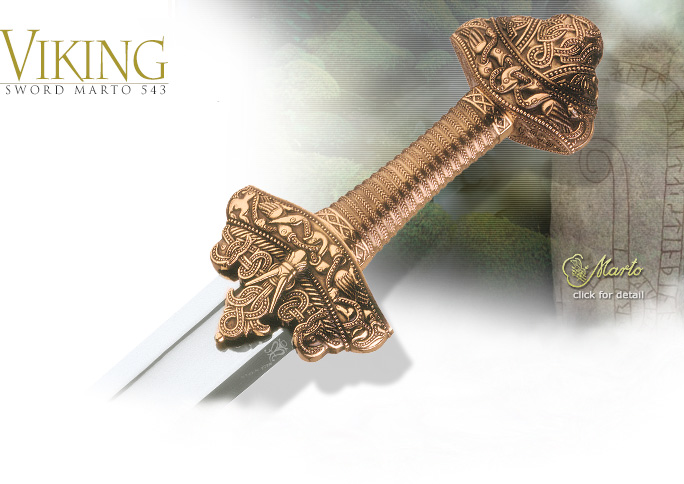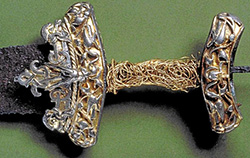SKåNE VIKING SWORD 543 MARTO of TOLEDO SPAIN 543 MARTO of TOLEDO SPAIN
The Vikings sacrificed highly prized and decorated weapons to the Gods in rivers and lakes. This magnificent Marto 543 sword is a replica of an original that was sacrificed and discovered in Skåne in Sweden. Today the original is on display at the Historical Museum in Stockholm. With its intricately sculptured bronze hilt, the Viking Sword (MARTO 543) reflects the strength of the fierce Viking warriors of old, as well as the masterful skill of its craftsmen. The 36-1/2 inch blade of this highly decorative piece is forged of high strength AISI 440 stainless steel and is fully tempered. The Toledo steel blade is polished to a lustrous mirror finish making it rust resistant requiring minimal care.
Toledo is famous for its historical character, its art and its steel. Marto inherits the testimony of the sword manufacturing traditions of Toledo Spain among the list of the most famous sword cutlers of all time.

Read more on Decorative Series Swords
|
|

• Overall length: 37.4" (95,5 cm)
• Blade length: 29.5" (75,5 cm)
• Length of guard: 3.9" (10,5 cm)
• Blade width at guard :2.0"(52 mm)
• Edge: Dual-sided Factory Dull
• Blade Material: AISI 440 Stainless Steel
• Blade thickness: 0.19" (5 mm)
• Thickness blade edge approx. 1 mm
• Hilt: Bronze plated, cast from Zamac
• Sword Weight: 4 lbs 16 oz

Specs may vary slightly from piece to piece.
|
The Vikings sacrificed valuable and beautiful objects to the Norse gods and their forefathers at bridges and fords because they believed they were the boundary between the living and the deceased. Some of the most valuable and most beautifully decorated weapons with silver and gold inlays, as well as the finest jewelry with gemstones, were sacrificed.
According to Norse sources, some of the items were given names and may have belonged to deceased persons. Much suggests that several individual findings that have been interpreted to originate from graves, originate from offerings in rivers and lakes. The Vikings used special places in the landscape for these rituals. Bridges and fords were particularly important because they served as a boundary between the living and the deceased. Viking settlements and burial sites were almost always close to water or connected by a bridge.
|
|
 |